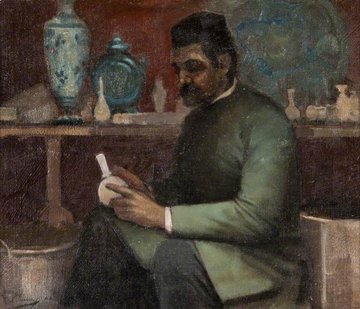
Glasgow International Exhibition, 1888
‐
An international exhibition of industry, science and art held in Glasgow in 1888, which hosted Indian and Sri Lankan workers
Place of event
Kelvingrove Park, Glasgow
About
The 1888 International Exhibition of Industry, Science and Art was the first in a series of international exhibitions held in Glasgow. It was held to showcase the city’s achievements in industry, science and art and to raise enough money to build an art gallery, museum and school of art. It followed the 1887 Royal Jubilee Exhibition held in Manchester. The Exhibition was opened by the Prince of Wales on 8 May 1888.
The main site was in Kelvingrove Park and was a quarter of a mile long. It contained thousands of displays including textiles, foodstuffs, musical instruments, fine art and shipbuilding. The central area known as the Indian Pavilion, built by Doulton and Co., was made of terracotta. The Indian Court, meanwhile, was adorned with textiles and carpets and housed nine Indian artisans: two woodcarvers, two potters, two jewellers and three sweet-makers. Visitors could buy their products, alongside spices and other wares. Men from Ceylon (now Sri Lanka) were brought over to Glasgow to serve tea to visitors in the Ceylon Tea House and the Royal Bungalow Dining Room.
John Muir, the proprietor of James Findlay & Co., a Glasgow cotton manufacturing firm that was moving into tea and jute, helped organize the Indian displays. T. N. Mukharji, the Bengali civil servant who had visited the 1886 Colonial and Indian Exhibition in London, helped select works for display. Mukharji also wrote a guide, The Art Manufactures of India, to accompany the Glasgow exhibition. The display included ornate caskets, ostrich feather fans and a silver palanquin.
John Lavery, who was part of a group of artists known as the Glasgow Boys, produced forty on-the-spot sketches of the exhibition, including one of the Indian potters.
The exhibition ended in November 1888 and recorded 5,748,379 visits.
T. N. Mukharji
Kinchin, Perilla and Kinchin, Juliet, Glasgow’s Great Exhibitions (Wendlebury: White Cockade Publishing, 2001)
Nenadic, Stana, 'Exhibiting India in Nineteenth-Century Scotland and the Impact on Commerce, Industry and Popular Culture', Journal of Scottish Historical Studies 34.1 (2014), pp. 67–89
Ranasinha, Ruvani (ed.) South Asians and the Shaping of Britain, 1870–1950 (Manchester: Manchester University Press, 2012)
Spooner, Rosemary, ‘Day-Tripping: Urban Excursions and the Architecture of International Exhibitions’, Architectural Theory Review 23.3 (2019), pp. 326–44
Kelvingrove Art Gallery and Museum, Glasgow
Mitchell Library, Glasgow
M. M’G., ‘A Lady’s Day at the Glasgow Exhibition’, Indian Magazine (October 1888), pp. 540–6
The Scotsman (28 June 1888)
Special Collections, University of Glasgow
Image credit
‘Potter at Work’ by John Lavery (1856–1941); photo credit: Glasgow Life Museums, licensed under CC BY-NC-ND, https://creativecommons.org/licenses/by-nc-nd/4.0/
